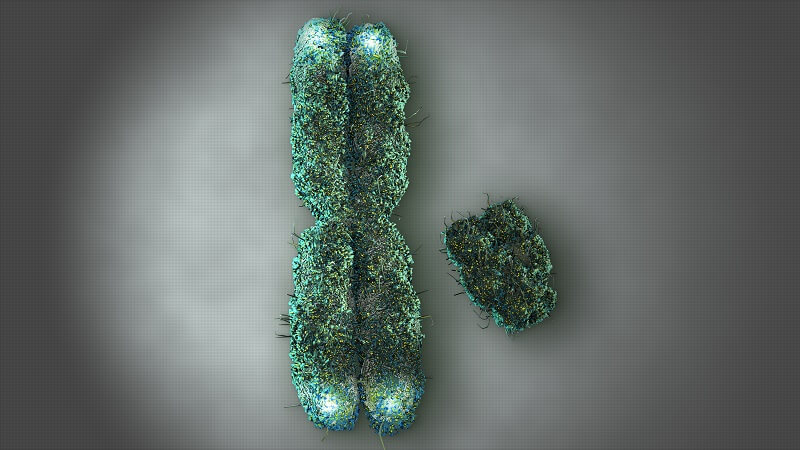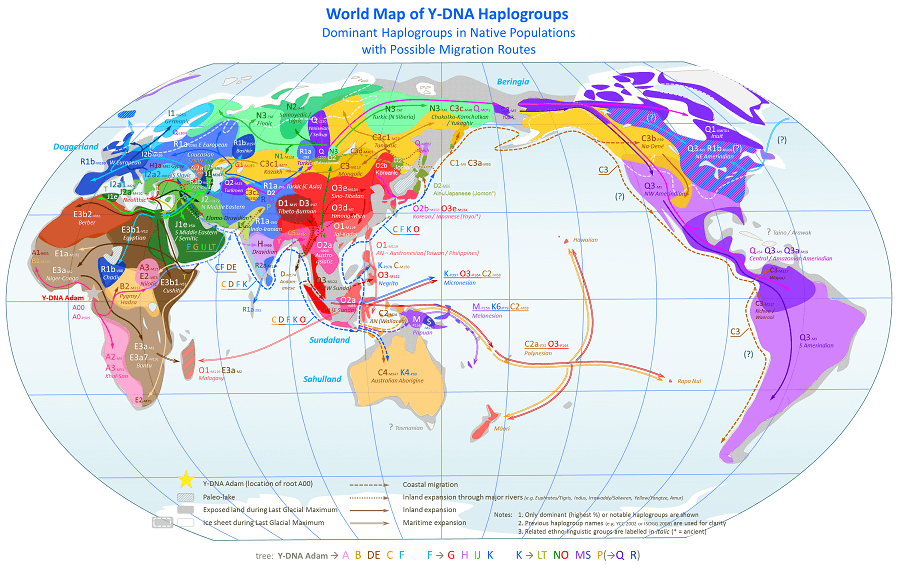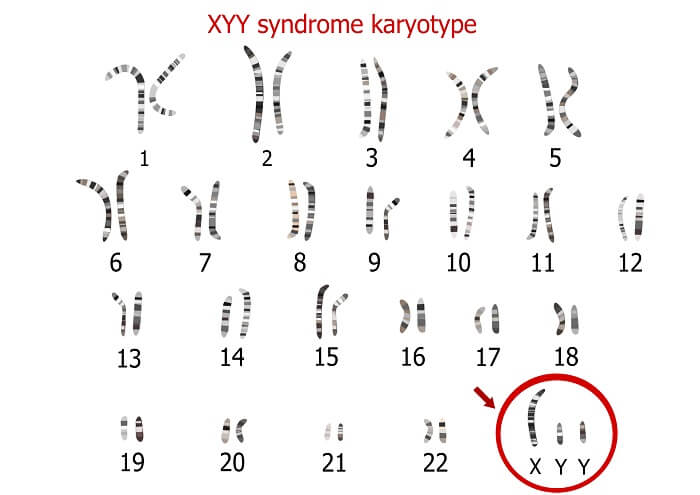Definition
The Y chromosome is one of the 46 (23 pairs) of chromosomes in humans, and also exists in many other mammals. The Y chromosome is one of the sex chromosomes, the other being the X chromosome.
Typically, individuals have a pair of sex chromosomes. Only males have a Y chromosome, and they also have one X chromosome (XY). Females usually have two X chromosomes (XX). However, there are exceptions to this, discussed below.

Y Chromosome Genetics
Inheritance of the Y chromosome
As with all the chromosomes, the Y chromosome is passed to individuals during the process of fertilization, when two gametes (eggs in females, sperm in males) fuse. Both gametes carry one copy of every chromosome (23 chromosomes). When they come together, they create a zygote with 23 pairs of chromosomes (46 chromosomes in total) that will develop into a new individual.
An XX female can only pass on an X chromosome, whereas an XY male either passes on an X chromosome or a Y chromosome to the offspring. If the sperm that fertilizes the egg has an X chromosome, the individual will be XX and typically a female; if the male sperm has a Y chromosome, the individual will be XY and typically male.
Structure of the Y chromosome
The human Y chromosome is the smallest of all the chromosomes in humans. It contains 59 million nucleotides of DNA and represents about 2% of the total DNA in males. For context, the largest chromosome in humans (chromosome 1) contains 249 million nucleotides.
The Y chromosome has very little genes, only around seventy protein-coding genes. One of the most critical genes is the SRY (sex-determining region Y) that initiates male development.
Y Chromosomal Adam
Y chromosomal Adam is the name given to the most recent common ancestor from which all human males descend, thought to have lived around 200,000 years ago. Of course, he was not the only male alive at the time. However, the Y chromosome of all males alive today can be traced back to this one particular individual.
Mutations in the Y-DNA are used to define haplogroups. These haplogroups reflect the ancestral origins of the paternal lineage of an individual.

Function of the Y chromosome
Determining the Male Phenotype
Whereas the X chromosome carries many different genes with various functions, the Y chromosome essentially only exists to specify the male phenotype.
The default state for a developing embryo is ‘female.’ At around six weeks into embryonic development, the SRY gene becomes active. This gene is considered the ‘master switch’ of sex determination in mammals. When the gene is ‘on’, the gene product, the SRY protein, (also called the testis-determining factor (TDF)) is expressed. This protein is a DNA-binding factor that binds to and promotes the expression of other transcription factors and thus sets off a signaling cascade to start male development.
The most important of the SRY-controlled factors is SOX9. When this gene is activated, it initiates the critical processes involved in male development. This includes the formation of the sex cords that develop into the testes and inhibiting the development of female characteristics.
The deletion of the SRY gene (or any mechanism of its inactivation) would result in female development, even if the individual has a Y chromosome.
Other Roles
The Y chromosome also has some other roles, including in male fertility and, perhaps surprisingly, in hearing.
Three regions present on the Y chromosome called azoospermia factor a, b, and c (AZFDa, AZFDb, and AZFDc) are necessary for proper sperm development. Deletions of genes in these regions are associated with infertility due to the absence of sperm and other defects in germ cell formation.
Additionally, mutations in the DFNY1 gene have been linked to male-specific deafness, associated with a complex rearrangement of the chromosome and chromosome 1.
Clinical Relevance
Unlike the other chromosomes, the alterations to the Y chromosome seems to have relatively little functional consequences (outside of a few key genes such as SRY). However, the Y chromosome is implicated in a variety of sex chromosome disorders.
Sex Chromosome Disorders
Having incorrect numbers of chromosomes is very rarely viable in humans. There are a few exceptions to this rule, for example, three copies of chromosome 21 results in Down Syndrome, and three copies of chromosome 18 caused Edward Syndrome.
However, disorders arising from extra copies of the sex chromosomes are much more likely to result in a live birth. Therefore, there are a variety of different potential genotypes and phenotypes both between and within these disorders. Below are some examples that relate to the Y chromosome.
- Turner Syndrome (XO) – Turner Syndrome is an absence of one of the sex chromosomes, meaning the affected person has 45 chromosomes in total. These individuals are phenotypically female but are have altered development that leads to short stature, infertility, and other health problems.
- Klinefelter Syndrome (XXY) – Klinefelter Syndrome is the presence of an extra X chromosome, meaning the individual has 47 chromosomes in total. The individual still carries a Y chromosome, so they are phenotypically male, but they have altered development and – in some cases – some additional health problems.
- XYY Syndrome – XXY syndrome, also called YY syndrome, is a rare disorder caused by the presence of an extra copy of the Y chromosome in males. Therefore, like those with Klinefelter syndrome, they have a total of 47 chromosomes. Affected individuals are usually very tall and sometimes have intellectual disabilities. They also often suffer from severe acne in their teenage years. However, in some cases, the symptoms are not obvious, and affected individuals show normal development. As a result, many of those affected are not diagnosed until later in life.

- XX male syndrome – XX male syndrome is a rare disease that is caused by aberrant recombination between X and Y chromosomes in the father’s gametes. The result is one of the X chromosomes carrying a portion of the Y chromosome. If this portion carries the SRY gene, male development will be initiated. As a result, the individual will be phenotypically male, despite having an XX genotype.
Androgen Insensitivity Syndrome
Androgen insensitivity syndrome is a rare disease in which an individual has a male genotype (XY) but does not fully develop the male phenotype, and may, in fact, possess entirely female characteristics. This happens because their cells are not responding to the typical effects of male sex hormones.
There are various degrees of severity of this disorder. Partial androgen insensitivity could result in the presence of male genitalia, female genitalia, or genitalia that have both male and female characteristics. In contrast, complete androgen insensitivity, which causes individuals to develop external female characteristics but with undescended male testes and an absence of a uterus. Complete androgen insensitivity is often not detected until puberty.
Loss of Y chromosome (LOY)
As men age, some of their cells can lose their Y chromosomes. This results in a form of genetic mosaicism, meaning that cells in the same individual have a different genotype. Smoking is thought to put men at increased risk of this, and LOY is linked to reduced life expectancy.
Forensic Significance
The Y chromosome can be useful in forensic science. Y chromosome analysis is most often used when detectives are investigating sexually motivated crimes perpetrated by a male against a female. This is because the Y chromosome allows the male DNA to be separated from the female victim’s DNA.
However, the Y chromosome has less power to distinguish between individuals than autosomal DNA because the sex chromosomes do not undergo recombination. This means that the sequences are inherited together, and are only changed by mutations over time. These inherited mutations are what we call the haplotype. Men who share haplotypes belong to the same haplogroup. This type of analysis can be helpful in tracing ancestral origins, all the way back to Y chromosomal Adam.
While this is helpful for tracing ancestry and identifying previously unknown connections, it is very difficult to differentiate between related individuals based on the Y chromosome sequence alone. However, it can be used to exclude suspects, generate new leads, and determine the paternal origin of the perpetrator in forensic investigations
Quiz
